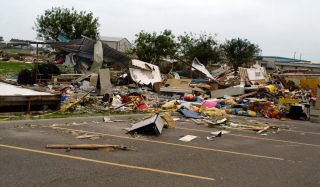Environment
Children and Adolescents Coping With Disaster
A new scientific study analyses disaster-coping strategies among youth.
Posted September 17, 2023 Reviewed by Jessica Schrader
Key points
- A new study explored what we know about outcomes from disaster-coping strategies for youth.
- Maladjustment appeared most for the coping strategies of escape, social isolation, submission, and opposition.
- The study shows how much work needs to be done to support youth dealing with disaster.
Disasters can produce huge psychological impacts, potentially affecting people for life. A recently published scientific study summarises what we know about outcomes from disaster-coping strategies for youth. It can help us to improve support for them while suggesting how to be better prepared.
Led by the University of Verona in Italy, with one co-author in Australia, the new study appeared in the journal Child & Youth Care Forum. The authors searched for any English paper in a scientific journal that dealt with people aged 18 years or younger who had experienced a disaster. To be included, a paper had to look at one or more post-disaster coping strategies and one or more indicators of maladjustment, such as mental health difficulties, or adjustment, such as emotion regulation.

The authors found 26 relevant studies. After coding each paper for reported relationships between coping strategies and maladjustment or adjustment, they calculated the size of the effect of coping strategies. Their calculations were correlations between the coping strategies and outcomes of maladjustment or adjustment. For maladjustment and adjustment separately, the authors examined the impact of each coping strategy, any differences between children and adolescents (apart from five papers that did not differentiate these groups), what the authors termed “type of disaster” as categorised by “earthquakes, floods and hurricanes, wildfires,” and the continent of the study, which the authors refer to as America, Europe, or Asia.
From the correlations, the authors suggest that maladjustment appeared most prominently for the coping strategies of escape, social isolation, submission, and opposition. Adjustment was seen primarily for problem-solving, social support, and submission. These results could suggest how to prioritize, focus, and train for support given to disaster-affected children and adolescents.
The authors describe clearly the limitations of the conclusions, especially the small number of studies available and the lack of homogeneity among them. Coping strategies, maladjustment/adjustment mechanisms, vocabulary, and analysis methods were not always the same between studies.
In the end, it could be that quantitative approaches might not yield the most robust advice. Improved connections with other disciplines could also enhance the interpretations.
A significant divergence from disaster research is the authors’ use of the phrase “natural disasters." They also refer to “disasters” as phenomena from the environment, with the labels “earthquakes, floods and hurricanes, wildfires.” Disaster science has long explained that disasters are not natural, because they are not caused by nature.
Rather than an earthquake being a disaster, the disaster is the collapsing infrastructure. People with decision-making power make choices to avoid measures that would stop seismic-related damage. This situation is demonstrated by places around the world that have avoided a disaster despite a large earthquake. It is the same for wildfires and floods (including those related to hurricanes).
In fact, the conflation of “floods and hurricanes” could have been reconsidered. First, as per the studies from Poland, not all floods come from hurricanes. Second, hurricanes bring different types of flooding, several which are rainfall-related, as well as ocean flooding, called storm surge. Hurricanes bring wind, too.
While most casualties from hurricanes are related to the flooding types, it would be interesting to explore whether or not various hurricane hazards produce varying results. A useful examination would also be whether or not the combination of hurricane hazards yields differences from each flooding type.
Choosing “continent” as a variable could be queried. The only country in Asia with studies is China. The only two countries in “America” are the USA and Chile, so two continents are combined, North America and South America. Considering the huge social and environmental differences between the USA and Chile, it is not clear that they could be conflated. Same with Europe, since studies covered the widely different Greece, Italy, and Poland.
In fact, one accepted baseline in disaster research is the importance of local context. All scales are important: individual, household, family, neighbourhood, through to municipality, country, continent, and world—and every scale in between.
Focusing on country and then scaling it up to categorize by continent(s) loses the nuancing evident across other scales. Notably, neighbours can experience vastly disparate disaster impacts based on, for instance, economic status and employer support alongside characteristics such as sex, gender, sexuality, race, ethnicity, and health. Or, for example, in an earthquake, whether or not their dwelling was seismically reinforced. The authors’ focus on country/continent is a useful piece within the full jigsaw, while missing the depth and breadth inherent in localized and individualized explorations.
Consequently, the importance of this new study is demonstrating how much work remains to be done to support youth in dealing with the horrific experience of disaster. The authors point out other examples of analyses that could not be conducted on their set of papers due to a dearth of data, including by gender and time elapsed after the disaster.
A wealth of data does exist from psychologists and other health professionals who deal with disaster-affected people. The authors of this new study pooled existing publications to generate an overall understanding, providing a powerful overview of what has and has not been published. Scientists could reach out more to professionals for documenting and analysing their immense experience and wisdom.
References
Raccanello, D., E. Rocca, V. Barnaba, G. Vicentini, R. Hall, and M. Brondino. 2023. Coping Strategies and Psychological Maladjustment/Adjustment: A Meta‑Analytic Approach with Children and Adolescents Exposed to Natural Disasters. Child & Youth Care Forum, vol. 52, pp. 25-63.




